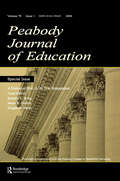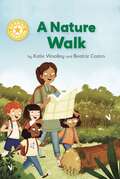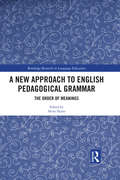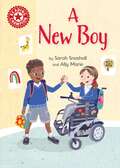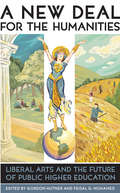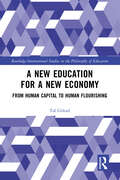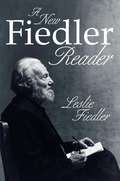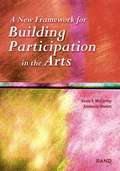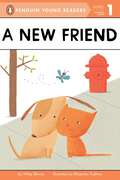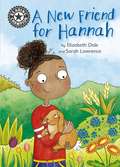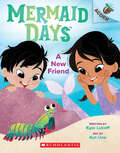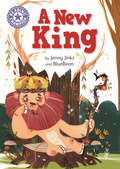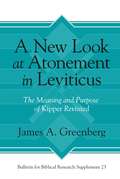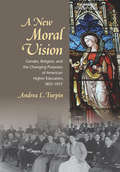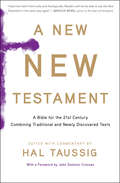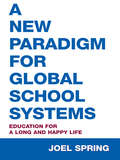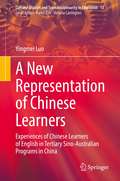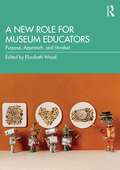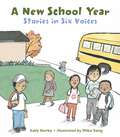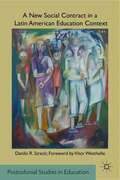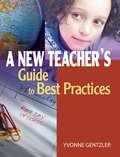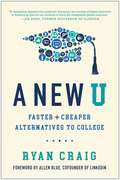- Table View
- List View
A Nation at Risk: A 20-year Reappraisal. A Special Issue of the peabody Journal of Education
by James W. Guthrie Kenneth K. Wong Douglas N. HarrisThis special issue examines the underlying assumptions of the "A Nation At Risk" report, the context within which the Commission's work was situated, and the effects of the report in improving teaching and learning, as well as the performance of the public educational system. The purpose is to address three broad questions: Was America's education system really putting the nation at risk in the early 1980s? What is the legacy of "A Nation At Risk"? Given our current knowledge on education and human development, the report's overall concern is restated: What risks and opportunities lay before the nation today, and how will they affect the notion of a "learning society" and our public education system? Taken as a whole, the seven articles address the three broad issues identified regarding the past, current, and future of educational reform in the United States.
A Nature Walk: Independent Reading Yellow 3 Non-fiction (Reading Champion #515)
by Katie WoolleyThis story is part of Reading Champion, a series carefully linked to book bands to encourage independent reading skills, developed with Dr Sue Bodman and Glen Franklin of UCL Institute of Education (IOE)Reading Champion offers independent reading books for children to practise and reinforce their developing reading skills.Fantastic, original stories are accompanied by engaging artwork and a reading activity. Each book has been carefully graded so that it can be matched to a child's reading ability, encouraging reading for pleasure.
A New Approach to English Pedagogical Grammar: The Order of Meanings (Routledge Research in Language Education)
by Akira TajinoThis book proposes Meaning-order Approach to Pedagogical Grammar (MAP Grammar) as a practical pedagogical approach in ESL and EFL contexts. Teaching grammar through an easy-to-understand three-dimensional model, MAP Grammar establishes the clause as the fundamental unit of English and interprets meaning units in the sentence, thus allowing visualizable association between individual grammar items. By focusing on the order of meaning (rather than the order of words) in a sentence, MAP Grammar also distills current descriptive sentence structures (typically taught as five or seven patterns) into one meaning-based sentence structure for teaching and learning. MAP Grammar makes syllabus design and teaching easier in the following ways: Visualizing English grammar in a clear model, allowing association between individual grammar items. Instruction relies on meaning, not metalanguage, making MAP Grammar easy to grasp. The meaning-based sentence structure allows teachers to address global errors, and learners to produce comprehensible English.
A New Approach to Research Ethics: Using Guided Dialogue to Strengthen Research Communities
by Henriikka Mustajoki Arto MustajokiA New Approach to Research Ethics is a clear, practical and useful guide to the ethical issues faced by researchers today. Examining the theories of ethical decision-making and applying these theories to a range of situations within a research career and process, this text offers a broader perspective on how ethics can be a positive force in strengthening the research community. Drawing upon a strong selection of challenging case studies, this text offers a new approach to engage with ethical issues and provides the reader with: a broader view on research ethics in practice, capturing both different stages of research careers and multiple tasks within that career, including supervision and research assessments thoughts on questions such as increasing globalisation, open science and intensified competition an increased understanding of undertaking research in a world of new technologies an extension of research ethics to a multidisciplinary and interdisciplinary approach an introduction to a ‘guided dialogue’ method, which helps to identify and engage with ethical issues individually and as a research community. A New Approach to Research Ethics allows for self-reflection and provides guidance for professional development in an increasingly competitive area. Full of valuable guidance for the researcher and ethical decision-maker, this is an essential text for postgraduate students, senior academics and developers of training courses on ethics for researchers.
A New Boy: Independent Reading Non-fiction Red 2 (Reading Champion #516)
by Sarah SnashallThis book is part of Reading Champion, a series carefully linked to book bands to encourage independent reading skills, developed with UCL Institute of Education (IOE)A New Boy is a non-fiction text reporting on welcoming a new child into the school. The repeated sentence structure offers readers the opportunity for a first independent reading experience with the support of the illustrations.Reading Champion offers independent reading books for children to practise and reinforce their developing reading skills.This early non-fiction text is accompanied by engaging artwork and a reading activity. Each book has been carefully graded so that it can be matched to a child's reading ability, encouraging reading for pleasure.
A New Creature
by Cheyenne NixonA boy&’s father goes to tuck his son in at bed time and before they say their prayers asks if Jesus lives in his heart. The boy says no, and his father begins to tell him about the sinner&’s prayer and explains who Jesus is. &“When He lives in you, you become a new creature&”, the father says to his son. This is derived from the scripture II Corinthians 5:17, &“Therefore if anyone is in Christ, he is a new creature; the old things passed away; behold, new things have come.&” The boy hears all about how Jesus Christ makes us new and accepts Him into his heart. He gets up the next morning and looks in the mirror to see if he has changed. The boy goes on a journey discovering his new life in Christ by going to church, praying, studying the bible, witnessing to friends and drawing pictures about bible stories. A problem comes to test him when he is approached by a bully in school and pushed down to the floor. His immediate reaction is to get up and hit his schoolmate, but the Holy Spirit speaks to him and tells him not to. Discouraged, our protagonist walks home and tells his mother what happened, and she encourages him that he did the right thing. As the child goes on a bike ride, he thinks about his actions and asked the Lord to forgive him for getting upset. He then spots the bully who begins to laugh and taunt him. The boy decides to approach the bully with kindness and tell him hello and forgives him of his actions. This causes the schoolmate to think about what he did and says sorry to the boy. As they make up, the boy invites his new friend in for a piece of cake. The boy now understands that becoming a new creature isn&’t an overnight outward change, but a process of developing a relationship with Christ who has the ability to change our hearts and minds.
A New Deal for the Humanities
by Feisal G. Mohamed Jeffrey J. Williams Christopher Newfield Kathleen Woodward Gordon Hutner Roger L. Geiger Daniel Lee Kleinman John Mcgowan Charlotte Melin Sheldon Rothblatt Yolanda Moses Bethany NowviskieMany in higher education fear that the humanities are facing a crisis. But even if the rhetoric about "crisis" is overblown, humanities departments do face increasing pressure from administrators, politicians, parents, and students. In A New Deal for the Humanities, Gordon Hutner and Feisal G. Mohamed bring together twelve prominent scholars who address the history, the present state, and the future direction of the humanities. These scholars keep the focus on public higher education, for it is in our state schools that the liberal arts are taught to the greatest numbers and where their neglect would be most damaging for the nation. The contributors offer spirited and thought-provoking debates on a diverse range of topics. For instance, they deplore the push by administrations to narrow learning into quantifiable outcomes as well as the demands of state governments for more practical, usable training. Indeed, for those who suggest that a college education should be "practical"--that it should lean toward the sciences and engineering, where the high-paying jobs are--this book points out that while a few nations produce as many technicians as the United States does, America is still renowned worldwide for its innovation and creativity, skills taught most effectively in the humanities. Most importantly, the essays in this collection examine ways to make the humanities even more effective, such as offering a broader array of options than the traditional major/minor scheme, options that combine a student's professional and intellectual interests, like the new medical humanities programs. A democracy can only be as energetic as the minds of its citizens, and the questions fundamental to the humanities are also fundamental to a thoughtful life. A New Deal for the Humanities takes an intrepid step in making the humanities--and our citizens--even stronger in the future.
A New Education for a New Economy: From Human Capital to Human Flourishing (Routledge International Studies in the Philosophy of Education)
by Tal GileadProviding an in-depth, novel analysis of education’s role in today’s economy by scrutinizing its theoretical underpinnings, this volume critiques the suitability of the current, dominant economic framework for education and for shaping educational policymaking worldwide.Critically examining the history and philosophy that underpin our present societal understanding of the link between economics and education, the book argues for an urgent redefining of education’s role in the economy based on intellectual foundations that significantly differ from our current, dominant conceptions. Across seven chapters, the book posits that the adoption of a new philosophical framework, the reshaping of economic and educational aims, and the adjustment of our educational system are each necessary to better promote human flourishing.Ultimately providing a platform to entirely reconsider the idea that the primary aim of education is to serve the economic system – in particular, economic growth – this book will appeal to scholars, researchers, and postgraduate students studying educational policy, the philosophy of education, and the history of education more broadly. Education policymakers and academics studying education and the economy may also find this book of interest.
A New Fiedler Reader
by Leslie A. FiedlerLeslie Fiedler's radical opinions and theories have changed the way we think about literature and pop culture, challenging long-established schools and ushering in a genre of first-person, experience-based criticism. His views, such as suggesting that college students read Timothy Leary along with John Milton, and his willingness to treat comic books, soap operas, soft porn movies, and romance novels as seriously as the canonical great books, often outraged an intellectual community that labeled him controversial, obscene, and annoying. Fiedler was accused of corrupting the young with dangerous leftist ideas that challenge some of the most dearly held traditional beliefs and easy affirmations, as well as unqualified pieties and allegiances. Now praised and respected as "one of the most important figures in the history of American cultural thought in this century," Fiedler has been applauded for introducing groundbreaking concepts that currently permeate university studies i! n literature. Designed to delight Fiedler's contemporary audience and introduce the author to a whole new generation of readers, A NEW FIEDLER READER is a captivating anthology of Fiedler's most notorious essays, from the often misread and maligned "Come Back to the Raft Ag'in, Huck Honey!" to the creative evaluation of an American literary giant in "An Almost Imaginary Interview: Hemingway in Ketchum." Also included are more recent essays, such as "In Every Generation: A Meditation on the Two Holocausts" and "Who's the Cowboy? Who's the Indian? The Slowest Gun in the West." Complementing these essays are various lesser-known poems and short stories, providing the reader with the complete Fiedler experience.
A New Framework for Building Participation in the Arts
by Kevin F. Mccarthy Kimberly J. JinnettArts organizations across the country are actively expanding their efforts to increase public participation in their programs. This report presents the findings of a RAND study sponsored by the Wallace-Reader's Digest Funds that looks at the process by which individuals become involved in the arts and attempts to identify ways in which arts institutions can most effectively influence this process. The report presents a behavioral model that identifies the main factors influencing individual decisions about the arts, based on site visits to institutions that have been particularly successful in attracting participants to their programs and in-depth interviews with the directors of more than 100 institutions that have received grants from the Wallace-Reader's Digest Funds and the Knight Foundation to encourage greater involvement in the arts. The model and a set of guidelines to help institutions approach the task of participation building constitute a framework that can assist in devising participation-building approaches that fit with an institution's overall purpose and mission, its available resources, and the community environment in which it operates--in other words, a framework that will enable arts institutions to take an integrative approach to building participation in the arts.
A New Friend (Penguin Young Readers, Level 1)
by Wiley BlevinsMeet two unlikely—and adorable—friends! Dogs and cats aren&’t supposed to be friends. Dogs chase and bark at cats. But this dog and cat know real friendship when they feel it, and nothing will keep them apart! This simple Level 1 reader will give young children a sweet introduction to both reading and friendship.
A New Friend For Hannah: Independent Reading 11 (Reading Champion #297)
by Elizabeth DaleHannah doesn't like her new home - she misses her friends. Then she finds a rabbit in the garden, and things begin to look a little brighter.Reading Champion offers independent reading books for children to practise and reinforce their developing reading skills.Fantastic, original stories are accompanied by engaging artwork and a reading activity. Each book has been carefully graded so that it can be matched to a child's reading ability, encouraging reading for pleasure.The Key Stage 2 Reading Champion Books are suggested for use as follows:Independent Reading 11: start of Year 3 or age 7+Independent Reading 12: end of Year 3 or age 7+Independent Reading 13: start of Year 4 or age 8+Independent Reading 14: end of Year 4 or age 8+Independent Reading 15: start of Year 5 or age 9+Independent Reading 16: end of Year 5 or age 9+Independent Reading 17: start of Year 6 or age 10+Independent Reading 18: end of Year 6 or age 10+
A New Friend: An Acorn Book (Mermaid Days)
by Kyle LukoffVera and Beaker make a new friend when they meet a mantis shrimp, in this series perfect for beginning readers!Pick a book. Grow a Reader!This series is part of Scholastic's early reader line, Acorn, aimed at children who are learning to read. With easy-to-read text, a short-story format, plenty of humor, and full-color artwork on every page, these books will boost reading confidence and fluency. Acorn books plant a love of reading and help readers grow!Swim along with mermaid Vera and octo-kid Beaker! In these three stories, Vera and Beaker make a new friend with a powerful baby mantis shrimp. Together, they explore the town of Tidal Grove. Then they play fun underwater games! Young readers will love discovering Vera and Beaker’s funny adventures and learning nonfiction information about mantis shrimp. Did you know that mantis shrimp are small but very powerful? They can punch the water to create shockwaves!With text from National Book Award finalist Kyle Lukoff, and bright, colorful artwork from artist Kat Uno, Mermaid Days is sure to be every young reader’s favorite new series. Balancing easy-to-read text, endless humor and charm, light nonfiction, and a loveable cast of underwater creatures, these laugh-out-loud stories are the perfect fit for new readers!
A New King: Independent Reading Purple 8 (Reading Champion #629)
by Jenny JinksThis story is part of Reading Champion, a series carefully linked to book bands to encourage independent reading skills, developed with Dr Sue Bodman and Glen Franklin of UCL Institute of Education (IOE)Lion is tired of being king. He decides to hold a contest to see which animal is most deserving of the throne. You won't believe who crosses the finish line first!Reading Champion offers independent reading books for children to practise and reinforce their developing reading skills.Fantastic, original stories are accompanied by engaging artwork and a reading activity. Each book has been carefully graded so that it can be matched to a child's reading ability, encouraging reading for pleasure.
A New Look at Atonement in Leviticus: The Meaning and Purpose of Kipper Revisited (Bulletin for Biblical Research Supplement #23)
by James A. GreenbergIn this book, James A. Greenberg examines animal sacrifice in Priestly Torah texts found in Leviticus 1–16, Exodus, and Numbers. Through his analysis, Greenberg identifies a new valence of kipper as a process that produces a positive result between two objects and argues that the Israelite sanctuary exists to facilitate a connection between YHWH, sancta, and the Israelites through the medium of blood.Rather than beginning with a priori assumptions of what sacrificial terms and symbols mean, Greenberg allows his interpretation to develop through an accumulation of textual clues. To avoid the exegetical pitfalls of symbolic and structuralist approaches, he focuses on what the language of the ritual says about sacrifice and what it seeks to accomplish. His investigation considers why the flesh and blood of an animal are used by the priest as he mediates on behalf of the offerer through the medium of YHWH’s sanctuary, what the difference is between intentional and unintentional sin, how the meaning of kipper changes from one sacrifice to the next, whether the sanctuary can be both holy and unclean, and how priests conceive of YHWH’s interaction with sancta, the offerer, and the animal.A New Look at Atonement in Leviticus recalibrates our understanding of kipper and furthers our knowledge of the priestly cult in ancient Israel. It will especially interest scholars of Biblical Hebrew and the Old Testament in particular.
A New Moral Vision: Gender, Religion, and the Changing Purposes of American Higher Education, 1837-1917
by Andrea TurpinIn A New Moral Vision, Andrea L. Turpin explores how the entrance of women into U.S. colleges and universities shaped changing ideas about the moral and religious purposes of higher education in unexpected ways, and in turn profoundly shaped American culture. In the decades before the Civil War, evangelical Protestantism provided the main impetus for opening the highest levels of American education to women. Between the Civil War and World War I, however, shifting theological beliefs, a growing cultural pluralism, and a new emphasis on university research led educators to reevaluate how colleges should inculcate an ethical outlook in students—just as the proportion of female collegians swelled.In this environment, Turpin argues, educational leaders articulated a new moral vision for their institutions by positioning them within the new landscape of competing men's, women's, and coeducational colleges and universities. In place of fostering evangelical conversion, religiously liberal educators sought to foster in students a surprisingly more gendered ideal of character and service than had earlier evangelical educators. Because of this moral reorientation, the widespread entrance of women into higher education did not shift the social order in as egalitarian a direction as we might expect. Instead, college graduates—who formed a disproportionate number of the leaders and reformers of the Progressive Era—contributed to the creation of separate male and female cultures within Progressive Era public life and beyond.Drawing on extensive archival research at ten trend-setting men's, women's, and coeducational colleges and universities, A New Moral Vision illuminates the historical intersection of gender ideals, religious beliefs, educational theories, and social change in ways that offer insight into the nature—and cultural consequences—of the moral messages communicated by institutions of higher education today.
A New New Testament: A Bible for the Twenty-first Century Combining Traditional and Newly Discovered Texts
by Hal Taussig&“Important both historically and theologically. Readers will not be able to see the New Testament in the same way again.&” —Marcus Borg, author of The Heart of Christianity &“A New New Testament does what some of us never dreamed possible: it opens the treasure chest of early Christian writings, restoring a carefully select few of them to their rightful place in the broad conversation about who Jesus was, what he did and taught, and what all of that has to do with us now.&” —Barbara Brown Taylor, author of Leaving Church and An Altar in the World There are twenty-seven books in the traditional New Testament, but the earliest Christian communities were far more vibrant than that small number might lead you to think. In fact, many more scriptures were written and just as important as the New Testament in shaping early-Christian communities and beliefs. Over the past century, many of those texts that were lost have been found and translated, yet are still not known to much of the public; they are discussed mainly by scholars or within a context of the now outdated notion of gnostic gospels. In A New New Testament Hal Taussig is changing that. With the help of nineteen important spiritual leaders, he has added ten of the recently discovered texts to the traditional New Testament, leading many churches and spiritual seekers to use this new New Testament for their spiritual and intellectual growth. &“Remarkable . . . Not meant to replace the traditional New Testament, this fascinating work will be, Taussig hopes, the first of several new New Testaments.&” —Booklist
A New Paradigm for Global School Systems: Education for a Long and Happy Life (Sociocultural, Political, And Historical Studies In Education Ser.)
by Joel SpringThis volume—a major new contribution to Joel Spring’s reportage and analysis of the intersection of global forces and education—offers a new paradigm for global school systems. Education for global economic competition is the prevailing goal of most national school systems. Spring argues that recent international studies by econom
A New Representation of Chinese Learners: Experiences of Chinese Learners of English in Tertiary Sino-Australian Programs in China (Cultural Studies and Transdisciplinarity in Education #13)
by Yingmei LuoThis book examines Chinese tertiary students' experiences of learning English in Sino-Australian programs in China. Using an institutional ethnography, the book examines one well-established Sino-Australian program based at a Chinese university. The book explores the ways that participant students used the Chinese words, tropes and their meanings to describe their English learning experiences with both local Chinese and foreign English teachers. This book introduces an innovative theoretical framework, “representation theory with a multilingual perspective”, to analyse how Chinese students' everyday experiences are constructed and mediated through language, discourse and identity. This framework also highlights graphic examples of how concepts are created in both Chinese and English, and thus serves as a powerful tool for deconstructing dichotomies between China and the West. The aim of this book is, then, two-fold: to show how a novel theoretical lens can help us to develop more nuanced understandings of Chinese students, and to propose a new methodological and theoretical framework through which one can challenge the monolingual subjectivity and parochial views of both Chinese and Western conceptions.
A New Republic of Letters
by Jerome McgannA manifesto for the humanities in the digital age, A New Republic of Letters argues that the history of texts, together with the methods by which they are preserved and made available for interpretation, are the overriding subjects of humanist study in the twenty-first century. Theory and philosophy, which have grounded the humanities for decades, no longer suffice as an intellectual framework. Jerome McGann proposes we look instead to philology--a discipline which has been out of fashion for many decades but which models the concerns of digital humanities with surprising fidelity. For centuries, books have been the best way to preserve and transmit knowledge. But as libraries and museums digitize their archives and readers abandon paperbacks for tablet computers, digital media are replacing books as the repository of cultural memory. While both the mission of the humanities and its traditional modes of scholarship and critical study are the same, the digital environment is driving disciplines to work with new tools that require major, and often very difficult, institutional changes. Now more than ever, scholars need to recover the theory and method of philological investigation if the humanities are to meet their perennial commitments. Textual and editorial scholarship, often marginalized as a narrowly technical domain, should be made a priority of humanists' attention.
A New Role for Museum Educators: Purpose, Approach, and Mindset
by Elizabeth WoodA New Role for Museum Educators shows how learning happens in communities, how volunteers and professionals approach their work, the underlying principles and philosophies that guide the work of museum education, and how these practices are always evolving to remain relevant. Museum education in its most expansive definition is about communicating messages, creating learning experiences, and, at its most aspirational, promoting human development for people of all backgrounds, abilities, and circumstances. This edited volume revisits the legacy of museum education practices, reflecting on the changing context of community and the role of cultural institutions, and provides insights into new directions that museums can take with a visitor-centered mindset. It provides foundational concepts around educational philosophies that guide practice, applied methods and approaches for implementation, and the ethos of an educational institution intended to support community learning and engagement that are essential to provide for the wide-ranging needs of all audiences. International perspectives from a variety of museums are considered, including art museums, children’s museums, history museums and historic sites, science museums, botanical gardens, zoos, and aquariums. Chapters include thought-provoking reflections on contemporary practices, concrete examples from across the globe, and useful tools for anyone working with public audiences. Grounded in practice and informed by research, this volume will be a go-to resource for arts and cultural organization practitioners, particularly those working in Museum Education. It will also be essential reading for students of Museum Studies, Education, and related fields
A New School Year: Stories in Six Voices
by Sally DerbyIn a unique narrative, readers meet a diverse group of six children ranging in age from Kindergarten through fifth grade. With nerves and excitement each child gears up for a new school year by hustling in the morning, meeting new teachers and new classmates during the day, and heading home with homework and relief by day&’s end. Simple, bright illustrations focus on each child and his/her worries, hopes, and successes on the first day of school.
A New Social Contract in a Latin American Education Context
by Danilo R. StreckA New Social Contract in a Latin American Education Context is committed to what has become known as "perspective of the South:" understanding the South not as a geographical reference but as a vindication of the existence of ways of knowing and of living which struggle for their survival and for a legitimate place in a world where the respect for difference is balanced with the right for equality. The metaphor of the new social contract stands for the desire to envision another world, which paradoxically cannot but spring out of the entrails of the existing one. Could the same contract under which the colonial orders were erected serve as a tool for decolonizing relations, knowledge, and power? Consequently, what kind of education could effectively help structure a new social contract? These are some of the questions Streck addresses.
A New Teacher's Guide to Best Practices
by Yvonne GentzlerNew teachers begin their careers with great enthusiasm and purpose, but often face many challenges in their first years of teaching. A New Teacher's Guide to Best Practices supports new teachers with guidelines for applying best teaching practices to improve their professional effectiveness. Organized around the Interstate New Teacher Assessment and Support Consortium (INTASC) standards, this reflective workbook is full of best-practice tools and strategies. Each chapter focuses on a different teaching challenge-"practical problems" that teachers face daily-and offers research-based solutions, along with teacher tips and student perspectives from across the country. An invaluable resource for new teachers to use at their own pace, or for staff developers presenting teacher induction workshops, this richly detailed text invites new teachers to: Record their present beliefs Outline their aspirations Define their goals and objectives Set a course of action to reach those goals and objectives Enter into dialogue with colleagues and mentors for continued professional growth Through planning, self-reflection, and dialogue, new teachers can enrich their teaching experience, expand their personal and professional goals for success, and shape the way they view their practice and profession.
A New U: Faster + Cheaper Alternatives to College
by Ryan CraigEvery year, the cost of a four-year degree goes up, and the value goes down. But for many students, there's a better answer. So many things are getting faster and cheaper. Movies stream into your living room, without ticket or concession-stand costs. The world's libraries are at your fingertips instantly, and for free. So why is a college education the only thing that seems immune to change? Colleges and universities operate much as they did 40 years ago, with one major exception: tuition expenses have risen dramatically. What's more, earning a degree takes longer than ever before, with the average time to graduate now over five years. As a result, graduates often struggle with enormous debt burdens. Even worse, they often find that degrees did not prepare them to obtain and succeed at good jobs in growing sectors of the economy. While many learners today would thrive with an efficient and affordable postsecondary education, the slow and pricey road to a bachelor's degree is starkly the opposite. In A New U: Faster + Cheaper Alternatives to College, Ryan Craig documents the early days of a revolution that will transform—or make obsolete—many colleges and universities. Alternative routes to great first jobs that do not involve a bachelor's degree are sprouting up all over the place. Bootcamps, income-share programs, apprenticeships, and staffing models are attractive alternatives to great jobs in numerous growing sectors of the economy: coding, healthcare, sales, digital marketing, finance and accounting, insurance, and data analytics. A New U is the first roadmap to these groundbreaking programs, which will lead to more student choice, better matches with employers, higher return on investment of cost and time, and stronger economic growth.
